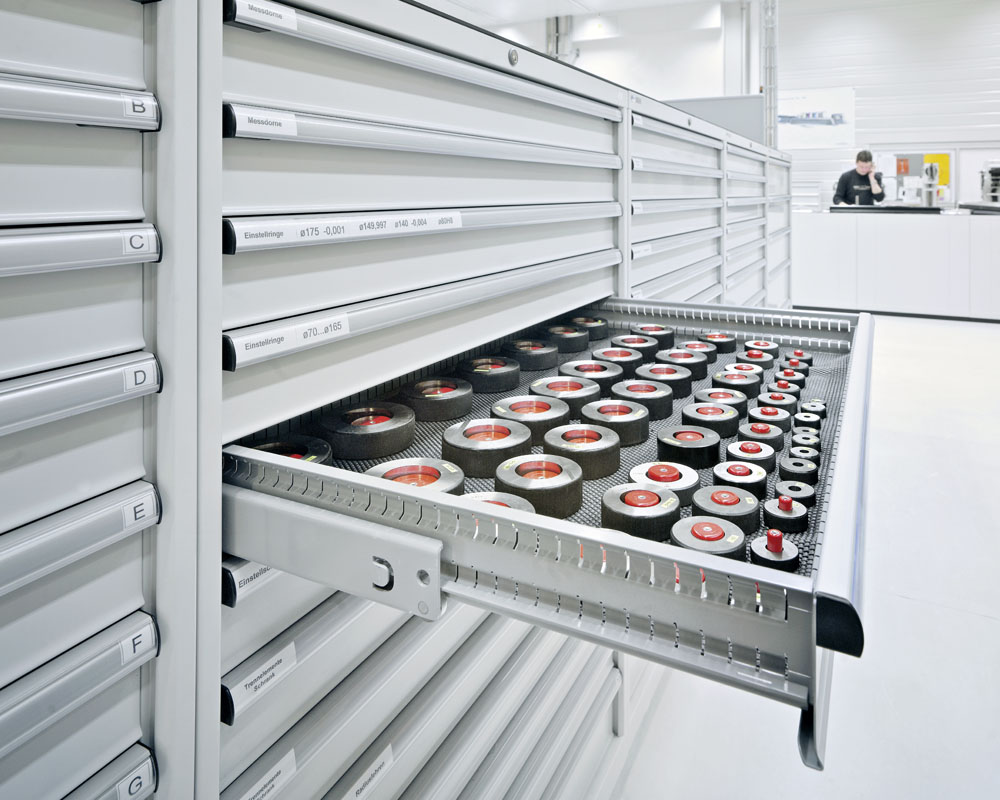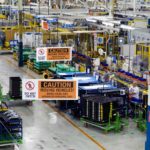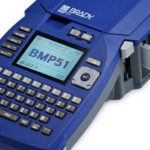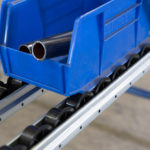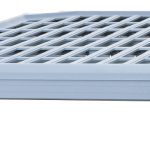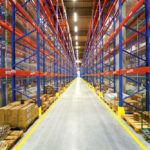Lean Manufacturing and the Environment
From the Environmental Protection Agency (EPA)
Introduction
Download the free 5S Hand-book PDF
5S is a system to reduce waste and optimize productivity through maintaining an orderly workplace using visual cues to achieve more consistent operational results. Implementation of this method “cleans up” and organizes the workplace basically in its existing configuration, and it is typically the first lean method which organizations implement.
The 5S pillars (originally 5 Japanese words, they have been loosely translated for English adaptation)
- Sort (Seiri)
- Set-in-order (Seiton)
- Shine (Seiso)
- Standardize (Seiketsu)
- Sustain (Shitsuke)
provide a methodology for organizing, cleaning, developing, and sustaining a productive work environment. In the daily work of a company, routines that maintain organization and orderliness are essential to a smooth and efficient flow of activities. This lean method encourages workers to improve their working conditions and helps them learn to reduce waste, unplanned downtime, and in-process inventory.
A typical 5S implementation would result in significant reductions in the square footage of space needed for existing operations. It also would result in the organization of tools and materials into labeled and color coded storage locations, as well as “kits” that contain just what is needed to perform a task. 5S provides the foundation on which other lean methods, such as TPM, cellular manufacturing, just-in-time production, and six sigma can be introduced.
Method and Implementation Approach
5S is a cyclical methodology: sort, set in order, shine, standardize, sustain the cycle. This results in continuous improvement.
The 5S Pillars
Sort
Sort, the first S, focuses on eliminating unnecessary items from the workplace that are not needed for current production operations. An effective visual method to identify these unneeded items is called “red tagging”. which involves evaluating the necessity of each item in a work area and dealing with it appropriately. A red tag is placed on all items that are not important for operations or that are not in the proper location or quantity. Once the red tag items are identified, these items are moved to a central holding area for subsequent disposal, recycling, or reassignment. Organizations often find that sorting enables them to reclaim valuable floor space and eliminate such things as broken tools, scrap, and excess raw material.
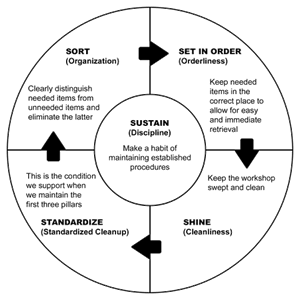
Set in Order
Set in Order focuses on creating efficient and effective storage methods to arrange items so that they are easy to use and put away. Set in Order can only be implemented once the first pillar, Sort, has cleared the work area of unneeded items. Strategies for effective Set in Order include painting floors, affixing labels and placards to designate proper storage locations and methods, outlining work areas and locations, and installing modular shelving and cabinets.
Shine
Once the clutter that has been clogging the work areas is eliminated and remaining items are organized, the next step is to thoroughly clean the work area. Daily follow-up cleaning is necessary to sustain this improvement. Working in a clean environment enables workers to notice malfunctions in equipment such as leaks, vibrations, breakages, and misalignment. These changes, if left unattended, could lead to equipment failure and loss of production. Organization often establishes Shine targets, assignments, methods, and tools before beginning the Shine Pillar.
Standardize
Once the first 3S’s have been implemented, the next pillar is to standardize the best practices in the work area. Standardize, the method to maintain the first three pillars, creates a consistent approach with which tasks are procedures are done. The three steps in this process are assigning 5S (Sort, Set in Order, Shine) job responsibilities, integrating 5S duties into regular work duties, and checking on the maintenance of 5S. Some of the tools used in standardizing the 5S procedures are: job cycle charts, visual cures (e.g., signs, placards, display scoreboards), scheduling of “5-minute” 5S periods, and check lists. The second part of Standardize is prevention- preventing accumulation of unneeded items, preventing procedures from breaking down, and preventing equipment and materials from getting dirty.
Sustain
Sustain, making a habit of properly maintaining correct procedures, is often the most difficult S to implement and achieve. Changing entrenched behaviors can be difficult, and the tendency is often to return to the status quo and the comfort zone of the “old way” of doing things. Sustain enforces on defining a new status quo and standard of work place organization. Without the Sustain pillar the achievements of the other pillars will not last long. Tools for sustaining 5S include posters, newsletters, pocket manuals, team and management check-ins, performance reviews, and department tours. Organizations typically seek to reinforce 5S messages in multiple formats until it becomes “the way things are done”.
Proper discipline keeps the 5S circle in motion.
Implications for Environmental Performance
Potential Benefits
Painting the machines and the equipment light colors and cleaning the windows, often done under the Shine pillar, decreases energy needs associated with lighting. Painting and cleaning makes it easier for workers to notice spills or leaks quickly, thereby decreasing spill response. This can significantly reduce waste generation from spills and clean-up.
The removal of obstacles and the marking of main thoroughfares decreases the potential of accidents that could lead to spills and associated hazardous waste generation (e.g., spilled material, absorbent pads and clean up materials). Regular cleaning, as part of the Shine Pillar, decreases the accumulation of cuttings, shavings, dirt, and other substances that can contaminate production processes and result in defects. Reduction in defects has significant environmental benefits (e.g., avoided materials, wastes, and energy needed to produce the defective output; avoided need to dispose of defective output).
5S implementation can significantly reduce the square footage needed for operations by organizing and disposing of unused equipment and supplies. Less storage space decreases energy needed to heat and light the space.
Organizing equipment, parts and materials so they are easy to find can significantly reduce unneeded consumption. Employees are more likely to finish one batch of chemicals or materials before opening or ordering more, resulting in less chemicals or materials expiring and needing disposal.
5S visual cues (e.g., signs, placards, scoreboards, laminated procedures in workstations) can be used to raise employee understanding of proper waste handling and management procedures, as well as workplace hazards and appropriate emergency response procedures. 5S techniques can be used to improve labeling of hazardous materials and wastes. In addition, environmental procedures are often separate from operating procedures, and they are not easily accessible to the workstation. 5S implementation often results in easy to read, laminated procedures located in workstations. Integration with 5S visual cues and operating procedures can improve employee environmental management.
Potential Shortcomings
Regularly painting and cleaning machines and equipment could lead to increased use of paints and cleaning supplies. Paints and cleaning supplies may contain solvents and/or chemicals that can result in air emissions or increased waste generation.
Disposing of unneeded equipment and supplies creates a short term surge in waste generation. In some cases, there may be unlabeled wastes that could be hazardous. Failure to involve environmental personnel in waste handling could result in some wastes being disposed improperly or in lost opportunities for reclamation or recycling.
Useful Resources
- Greif, M.. The visual Factory: Building Participation Through Shared Information (Portland, Oregon: Productivity Press, 1995).
- Hirano, Hiroyuki. 5 Pillars of the Visual Workplace (Portland, Oregon: Productivity Press, 1995).
- Peterson, Jim, Roland, Smith, Ph.D.. The 5S pocket Guide (Portland, Oregon: Productivity Press, 1998).
- Pojasek, Robert B. “5Ss: A Tool That Prepares an Organization for Change”. Environmental Quality Management (Autumn 1999) 97-103.
- Productivity Press Development Team. 5S for Operators: 5 Pillars of the Visual Workplace (Portland, Oregon: Productivity Press, 1996)
- Productivity Press Development Team. 5S Safety Implementation Toolkit: Creating Safe Conditions Using the 5S System (Portland, Oregon: Productivity Press, 2000)
- Productivity Press Development Team. 5S for Safety: New Eyes for the Shop Floor (Portland, Oregon: Productivity Press, 1999)
- Shimbun, Nikkan Kogyo, ed. Visual Control Systems (Portland, Oregon: Productivity Press, 1999)Tel-A-Train and the Productivity Development Team. The 5S System: Workplace Organizations Standardization (Video) (Portland, Oregon: Productivity Press, 1997).
Related Articles
- Three Points Important for Managing a 5S Process (brighthub.com)
- Lean Manufacturing and Safety Help Manufacturers Survive Tough Times (prweb.com)
Related Posts
-
New Accuform Manufacturing Signage
Are you in compliance? Do you qualify for an exemption? Generic signage no longer adheres to recent Proposition 65 updates. Custom order Accuform signage is now available from PAC. Our specialists tailor hazard signage for…
- Lean Cellular Manufacturing: Processing, Methods, Layouts, and Implementation
Cellular manufacturing helps reduce waste by reducing defects that result from processing and product changeovers. Since products or components move through a cell one piece at a time, operators can quickly identify and address defects.…
-
Brady BMP51 Label Printer
The BMP51 Label Maker has all the latest features for portable printing on the go: a large display screen, easy-to-use label design apps, fast print speed, and more. You can carry this printer throughout your…
-
Plastic or Corrugated Resuasable Bins Crates and Storage?
Reduce, Reuse, Recycle Reusable Plastic Containers (RPCs) have many advantages over corrugated paper containers: Reusable: RPCs can be used repeatedly with minimal wear and typically last anywhere from 20 to 100 times , versus a…
-
MetroMax iQ Storage System
Uniquely Justifiable... Designed with innovative polymers for longer-life product performance, easy-to-clean surfaces to promote a cleaner environment and higher level of food safety, interchangeable components for maximum flexibility, a truly unique way to improve operational…
-
Download the 5S Organization Guide Used By NASA, Boeing, & HP.
How Did the 5S Organization System Become Standard at NASA, Boeing, Hewlett-Packard, and Harley Davidson?

